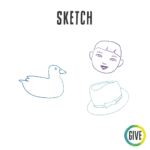Point of View
Contributed by Yael Ben-Zion
Description
Students will use photography or drawing to capture different points of view and reflect on the experience.
Directions
- Display three pictures taken from three different points of view (e.g., bird’s eye; eye level, worm’s eye).
- Ask them what differences they notice between the pictures, and how the points of view affect our perception.
- Introduce the concept of point of view.
- Ask students to pick an object, person, or place that is important to them, and take photos of it from three different points of view. (If they don’t have a camera, they can sketch it.)

- Ask them to write down what point of view they prefer and why.
- Invite a few students to share their work with the class.
Transition into Activity
Invite students to make a frame with their hands, and then guide them through a few changes to their position. At each position, invite them to look around; then discuss what they noticed.
Transition out of Activity
Finish up by saying that in your art, you can show your point of view, your story, your voice. You can discuss how this relates to the work you’ll do together.
Classroom Arrangement
Students can be at their desk and then around the room during the activity.
Supports/Adaptive Materials/Tools
- Use cameras, phone cameras, or paper and pencils to capture images.
- If there are not enough cameras, and/or to encourage collaboration, students can work in small groups.
- Use a visual timer or music to time the activity.
- Provide pencil grips for students who might be sketching instead of taking photos.
Possible Roles for Classroom Professionals
- Support students who need help with brainstorming, taking photos, or writing. In case the classroom has the means for uploading/printing images, they can help with this task.
Adjustments for Remote Instruction
Turn the activity into a scavenger hunt. After demonstrating point of view and bird’s-eye view, have students sketch something in their home—then when they share, have the other students try to guess what it is.
